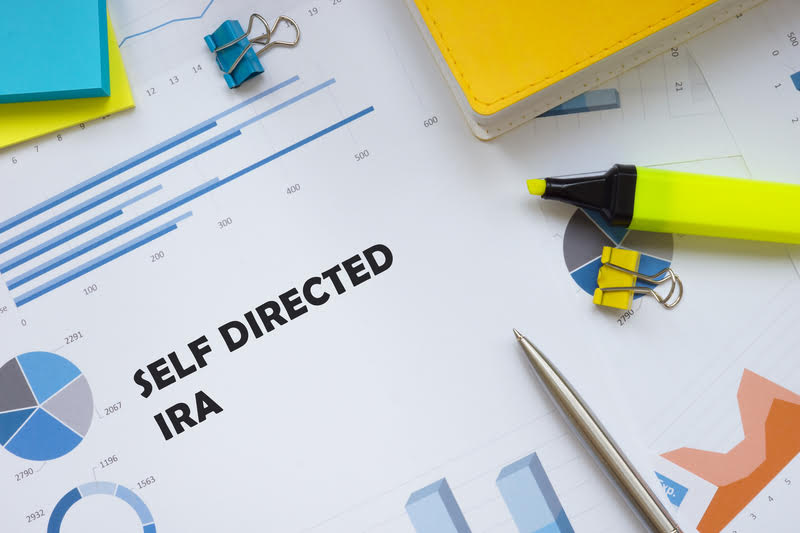Introduction
You want control over your financial destiny.
You’re tired of the mediocre returns and limited options of traditional IRAs and you’re looking to take your retirement savings into your own hands.
A self-directed IRA may be the solution you’ve been searching for.
With a self-directed IRA, you can invest in alternative assets beyond stocks, bonds, and mutual funds.
We’re talking real estate, private companies, precious metals, cryptocurrencies—the possibilities are vast.
By expanding your investment options, you can customize your portfolio to align with your interests and risk tolerance.
The tax-advantaged growth potential is unmatched.
However, greater control and opportunity mean greater responsibility.
You must adhere to a complex web of rules and regulations to reap the rewards and avoid harsh penalties.
The risks are real, but with proper planning and guidance, you can leverage a self-directed IRA to build the financial future you desire.
This article will walk you through everything you need to know to take advantage of the benefits of a self-directed IRA, from how they work and the types of investments allowed to required distributions, planning strategies, and risks to consider.
The path to financial freedom starts here.
Take control—a self-directed IRA awaits.
Defining a Self-Directed IRA
A self-directed IRA is an individual retirement account that provides you broad investment flexibility beyond stocks, bonds, and mutual funds.
You’re in the driver’s seat, directing a custodian to invest your funds in alternative assets of your choosing.
Traditional vs. Self-Directed IRAs
Unlike a traditional IRA limiting you to standard market-based investments, a self-directed IRA frees you to invest in real estate, private companies, cryptocurrencies, tax liens, and more.
The core difference is control. With a self-directed IRA, you maintain full control over investment decisions.
Role of a Custodian
A custodian holds your self-directed IRA account and approves investment transactions. They ensure all activity complies with IRS regulations.
Custodians act as a neutral third-party, executing investment decisions at your discretion. They cannot provide advice or report on investment performance.
You’ll likely need to engage other professionals to assess risks and opportunities related to potential self-directed IRA investments. But ultimately, you call the shots.
The custodian’s role is limited to administration, compliance, and safekeeping of assets. If you’re comfortable navigating complex IRS rules, the custodian will carry out your orders. But you better know what you’re doing.
Benefits of a Self-Directed IRA
The advantages of a self-directed IRA are significant. Let’s explore the top benefits.
Greater Investment Flexibility
A self-directed IRA blows open the doors of choice. You have unlimited freedom to invest in any IRS-approved asset.
See an opportunity in real estate, private companies, or cryptocurrencies? You can capitalize on it.
For those with niche interests and expertise, the flexibility provides a strategic advantage. You can invest in what you know best.
Built-in Tax Advantages
Like traditional IRAs, self-directed IRAs offer tax-advantaged growth. Withdrawals in retirement are taxed only as ordinary income (for traditional IRAs) or remain tax-free (for Roths).
Contributions may also be tax-deductible (for traditional IRAs), and earnings grow tax-deferred.
Over time, reduced taxes allow your funds to accumulate rapidly. If leveraging real estate, tax benefits are further maximized.
Alignment with Passions and Knowledge
A self-directed IRA also allows you to invest according to your personal interests and skills.
Are you knowledgeable in real estate, private lending, or cryptocurrency? Then put your know-how to work through strategic self-directed IRA investments.
You can pursue opportunities normally inaccessible in traditional IRAs, aligning your portfolio with your passions and expertise.
An informed investor is a successful investor. And with a self-directed IRA, you can invest in what you understand best.
Types of Investments Permitted

The options are vast with a self-directed IRA. Let’s explore some of the most common investment types allowed.
Real Estate Opportunities
Residential or commercial property, vacant land, mortgage notes—real estate abounds with possibility.
Rental income and gains can grow tax-free within your IRA. At distribution, the step-up in basis eliminates taxes on lifetime appreciation.
But use rules apply. You cannot reside in or benefit personally from properties held in your self-directed IRA. All income and expenses must flow through the IRA.
Private Placements
Private companies, hedge funds, tax liens, and private notes offer accredited investors additional diversification.
These investments tend to be riskier but also potentially more rewarding. Extensive due diligence is required to assess viability and ensure compliance.
Precious Metals and Coins
For those seeking an inflation hedge, gold, silver, platinum, and certain collectible coins are permitted holdings.
Only certain coins, like American Eagles and American Gold Buffalo coins, qualify based on precious metal content and market value.
Crypto Assets
Select cryptocurrencies, like Bitcoin and Ethereum, are allowed within self-directed IRAs.
While volatile, crypto provides exposure to an emerging asset class that could yield substantial long-term gains. But only invest money you can afford to lose.
Process of Setting Up
Establishing a self-directed IRA involves a few key steps. Follow along as we detail the process.
Opening an Account with a Custodian
You must open a self-directed IRA with a custodian that specializes in alternative asset accounts. They ensure compliance and approve transactions.
Complete an application providing personal information and the contribution type/amount. Account setup typically takes 2 to 3 weeks. Fees apply.
Custodians are not fiduciaries and offer no investment advice. But they will enforce all IRS regulations. Choose wisely based on experience, service, and fees.
Funding Your Self-Directed IRA
You can fund a self-directed IRA through contributions, transfers from existing IRAs, or rollovers from a 401(k) or other retirement accounts.
Contribute up to $6,000 annually, or $7,000 if 50 or older (the age limit will be 73 starting in 2023 under the SECURE Act). Transfers are tax-free and unlimited.
Rollovers also avoid tax consequences. Initiate a transfer or rollover by completing paperwork with your current provider directing funds to the new custodian.
Choosing Your Investments
Once funded, you can invest in any IRS-approved asset. Complete investment forms detailing the transaction for your custodian to review and process.
Do extensive due diligence to determine what investments best align with your goals and risk tolerance. The options are many, so choose wisely.
The custodian will execute investment purchases and sales per your direction but offers no advice or guidance. You must understand the complex rules surrounding self-directed IRAs to avoid violations.
Proceed cautiously and seek input from financial and legal professionals regarding investment choices. Your nest egg depends on it.
Understanding the Rules and Regulations
The flexibility of self-directed IRAs comes with significant responsibility. Stringent rules govern these accounts, and violating them results in harsh penalties. You must understand the regulations to succeed.
Prohibited Investments
Certain assets are off-limits, including collectibles, insurance contracts, and s-corporation shares. Why? They either provide personal enjoyment or control prior to retirement.
The IRS prohibits any investment that benefits you directly to maintain the tax advantages of retirement accounts. Review the list of forbidden investments before purchasing any asset.
Disqualified Persons and Prohibited Transactions
Strict rules also govern transactions between your IRA and “disqualified persons”—yourself, spouse, parents, children, fiduciaries.
Examples of prohibited transactions include buying or selling assets between parties, using IRA funds as collateral for your own loan, or benefiting personally from rental property held in the IRA.
Why? Again, the IRS curtails any self-benefit prior to retirement. Violating these rules results in account termination, taxes on holdings, and potential civil/criminal penalties.
Fiduciary Duties and Responsibilities
Those providing guidance or managing your self-directed IRA have fiduciary duties to act impartially and uphold compliance.
As account owner, you also have responsibilities like monitoring investments, tracking contributions/distributions, and filing an annual self-directed IRA tax form.
Custodians only ensure transactions follow rules. You must understand regulations to avoid violations that could disqualify the entire account—and fall back on fiduciaries if guidance provided proves problematic.
A self-directed IRA requires diligent oversight. If unwilling to actively direct and comply with complex rules, stick to a traditional IRA managed by a financial firm. The flexibility isn’t worth the risk of losing everything.
But for hands-on investors willing to do the work, opportunity abounds. Just know that responsibility comes first with a self-directed IRA. Follow the rules, or pay the price.
Risks Associated with Self-Directed IRAs

While the benefits of self-directed IRAs are significant, substantial risks exist. Ensure you understand the hazards before investing.
Potential for Fraudulent Schemes
Unfortunately, the flexibility of self-directed IRAs also attracts unscrupulous actors promoting fraudulent schemes to take advantage of unwary investors.
Do extensive due diligence on any investment and advisor. Look for red flags like guaranteed high returns, time sensitivity, opaque business models, and pushy sales tactics.
High-pressure sales and secrecy are not the marks of legitimate opportunities. Never rush into any investment without fully understanding the details and risks. It’s your nest egg on the line.
Increased Fees and Expenses
Self-directed IRAs often come with higher fees than traditional IRAs to cover the additional responsibilities and risks custodians undertake. Fees vary but may include:
- Account setup and maintenance: $200-$500 annually
- Transaction fees: $50-$200 per investment buy/sell
- Asset-based fees: A percentage of the account value ranging from 0.5%-2% annually depending on the custodian and account value.
Fees reduce earnings over time and should be an important consideration when choosing a custodian. Only pay for the services needed to avoid unnecessary expenses.
Volatility of Alternative Assets
While alternative investments offer substantial opportunity, their values also fluctuate frequently. Cryptocurrency, real estate, private companies—all carry risks.
Account values may drop dramatically at any time. Don’t invest money you may need short-term or can’t afford to lose.
Diversify holdings to reduce risk. And consider more stable assets like precious metals to balance higher-volatility options.
The rewards of self-directed IRAs are unparalleled, but so too are the risks. Understand hazards to investment success, and work with experienced professionals to craft a balanced portfolio aligned with your financial goals.
With eyes wide open to risk, self-directed IRAs can be safely navigated and generously rewarded. But go in blind, and losses may leave you with little to nothing for retirement.
Invest wisely.
Required Minimum Distributions and Early Withdrawals
Managing a self-directed IRA means adhering to rules on required minimum distributions (RMDs) and early withdrawals to avoid potential penalties. Let’s explore the specifics.
Understanding Required Minimum Distributions (RMDs)
The IRS mandates you withdraw a minimum amount from tax-advantaged retirement accounts starting April 1 of the year after turning 73. The age was recently increased from 72 under the SECURE Act.
RMDs ensure you spend retirement funds during your lifetime rather than using accounts for estate planning.
The RMD amount depends on your age, account balance, life expectancy, and whether funds are from one or multiple IRAs. A financial advisor can help ensure you withdraw the correct amounts each year.
Failing to take RMDs results in a 50% IRS penalty on the amount that should have been withdrawn. So, make RMDs a priority each year to avoid costing your nest egg.
Early Withdrawal Rules and Penalties
Withdrawing money from an IRA before age 59 1⁄2 typically incurs income taxes and a 10% early distribution penalty, reducing funds available for the future. But exceptions exist.
For Roth IRAs, you can withdraw contributions at any time without penalty since taxes were paid when money went in. Only earnings withdrawals prior to age 59 1⁄2 and the 5-year account seasoning period incur taxes/penalties.
Exceptions to Early Withdrawal Penalties
You may withdraw IRA funds before 59 1⁄2 without penalty if used for:
- Qualified education expenses: Paying for college tuition, fees, books, supplies, and equipment required for attendance. Limited to $10,000 lifetime.
- First-time home purchase: Withdrawing up to $10,000 for eligible costs like a down payment or closing fees. Limited to $10,000 lifetime.
- Unreimbursed medical expenses: Paying for expenses beyond a certain percentage of your income (currently 7.5%).
- Disability: If unable to work due to total disability.
- Death: Withdrawals by beneficiaries after your passing.
- IRS levy: Must withdraw funds to pay IRS levy.
- Certain military members: Qualifying reservists called to active duty for over 179 days.
Consult a tax professional to determine if your situation qualifies for an exception. Following the rules on RMDs and early withdrawals with a self-directed IRA is critical to avoid derailing your retirement plans.
Remain diligent, and you’ll keep the IRS at bay while enjoying the many benefits of an IRA.
Self-Directed IRA and Estate Planning
A self-directed IRA provides significant estate planning opportunities. When optimally utilized, it can generate and preserve wealth for your beneficiaries.
Incorporating Real Estate in Estate Planning
Investing in income-producing real estate allows growth and income to accumulate tax-deferred. At death, heirs inherit the property at market value, avoiding capital gains taxes on lifetime appreciation.
The tax benefits are huge if leveraging real estate in your self-directed IRA, especially for younger investors with a longer time horizon. Over decades, tax-free growth and income can build significant wealth for future generations.
Designating Beneficiaries and Allocating Assets
Properly designating beneficiaries and allocating self-directed IRA assets upon death provide substantial control over wealth transfer.
You can divide funds among multiple beneficiaries however desired. Appointing a trust as beneficiary allows further customization regarding how and when heirs access funds.
Consider providing different allocations/beneficiaries for stable vs. volatile account assets. Name successor trustees to assume account responsibility if beneficiaries are not financially adept.
With significant wealth at stake, beneficiary choices and allocations should align with your comprehensive estate plan. Consult legal counsel regarding optimal strategies based on your goals.
Utilizing Tax-Deferred Growth Strategies
Maximizing tax efficiency through strategic buying, selling, and withdrawals optimizes self-directed IRA value over the long run.
For example, buy and hold income-generating real estate for tax-deferred growth and income. Sell other assets at opportune times based on market conditions and tax rates to generate cash or rollover proceeds for new opportunities.
Withdraw money during periods of lower tax rates or in a state with no income tax. Coordinate withdrawals with income from taxable accounts to fill lower brackets.
Addressing Illiquidity Challenges
Many self-directed IRA investments are illiquid, so prepare for how assets will eventually be sold or accessed when needed for income or to benefit beneficiaries.
For real estate, determine if property will be sold, refinanced, or distributed via an in-kind transfer to beneficiaries. Have beneficiaries qualified to manage property if distributing directly?
Liquidity and succession planning are musts for leveraging illiquid investments. How funds are ultimately exited significantly impacts financial outcomes. Think long-term, even with volatile assets.
Exit Strategies and Successor Trustees
Unexpected life events necessitate planning for account continuity if unable to actively oversee holdings yourself.
Appoint successor trustees to step in if incapacitated or after death. Provide guidance on managing illiquid and volatile account investments.
Detail exit strategies for selling or transferring assets to beneficiaries. With substantial wealth at stake, failing to plan for account succession poses huge risks.
Discuss contingency plans and successor oversight with legal counsel and include in your broader estate planning strategies. Your self-directed IRA depends on it.
Using a self-directed IRA as an estate planning tool generates meaningful opportunities when factors like beneficiary choices, tax efficiency, succession planning, and liquidity challenges are properly addressed.
Account for risks tied to illiquid alternative assets, and put plans in place to handle whatever comes—good or bad. That’s the key to generational wealth through a self-directed IRA.
To Conclude
The time has come to seize control of your financial destiny. You now have the knowledge and tools to leverage a self-directed IRA and unlock new avenues of opportunity. This flexible, tax-advantaged account can align with your passions and help you build wealth on your own terms.
Act now. Do your research and choose a custodian to get started. Fund your account and select impactful investments attuned to your risk tolerance and expertise. Work with trusted advisors to ensure IRS compliance, minimize fees, and optimize your estate plan.
The road ahead holds challenges, but greater possibility awaits. Take risks when opportunity calls but proceed with care and due diligence. Let your self-directed IRA compound and grow over time through tax-deferred gains and strategic wealth preservation.
Build the financial future of your dreams. A self-directed IRA hands you the power to shape your legacy. Grasp this chance to invest in what ignites your curiosity and forge your own path to prosperity.
The time for action is now—opportunity will not wait. Seize your financial destiny today through the ultimate account designed for visionaries determined to invest in what they know and love. A bright future is yours to create. This is your call to adventure—answer it!











